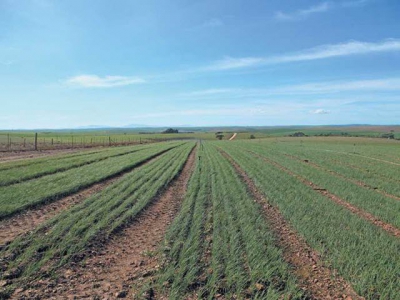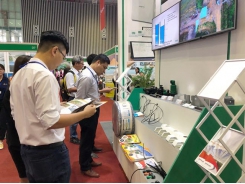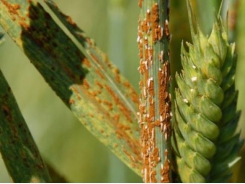Vegetable crops improve wheat yield

Many small-grain farmers in the Southern Cape have added brassicas in the form of canola to their crop rotation programmes. Jose de Kock talked to Glenneis Kriel about how he is taking this a step further by including vegetable brassicas, such as broccoli and cauliflower, in the rotation cycle.
Cousins Jose and Josais de Kock have adopted an unconventional crop rotation programme by including cauliflower and broccoli in their wheat rotation system. Jose says that this system has produced a wheat yield of 2t/ha to 3t/ ha more than that produced on the lucerne rotation programme. Photo: By Glenneis Kriel
Most farmers realise the importance of crop rotation in breaking disease cycles and alleviating farming risks. For wheat farmers in the Southern Cape and Swartland, however, the choice of crops to include in rotation programmes is fairly limited, and often involves only canola, barley or feed crops such as lucerne.
Jose de Kock and his cousin, Josias, farm wheat on the farm Klipheuwel, near Napier, and have adopted a rather unconventional crop rotation programme by including cauliflower and broccoli in their rotation system.
“My grandfather used a wheat-onion rotation when he farmed. All we did was to include other brassicas, including cauliflower and broccoli,” Jose says.
According to Jose, diversifying with cauliflower and broccoli has numerous production benefits, as brassicas not only break the disease cycle associated with intensive production systems and monocropping, but help to destroy soil pathogens through biofumigation.
“When brassicas are crushed, they exude a chemical that helps destroy pathogenic organisms in the soil. We therefore plough the cauliflower and broccoli back into the soil after harvesting to achieve the biofumigation effect,” he explains.
Cauliflower and broccoli crop residues are also fed to the farm’s sheep component, which consists of Dohne Merino ewes.
“We cut the green material off the land with a double-chop forage harvester after picking, and immediately thereafter supply the sheep with the green forage. We’re not planning on drying or baling the material,” Jose says.
Brassicas allow them to apply grass herbicides.
“Rotations have to be well planned and herbicides used selectively to prevent the development of herbicide resistance. Weed management entails sound record-keeping, and means you might have to alter your rotation system to get rid of a problem before it becomes too big.”
While canola has a considerably deeper root system than brassicas, and thus the added advantage of loosening the soil, broccoli and cauliflower do not produce seed, eliminating the regrowth problem in follow-up crops.
Planting and pests
The growing of cauliflower and broccoli seedlings is outsourced, and seedlings are planted at one month to one-and-a-half months of age. Plantings are spaced 300mm by 300mm apart, and grouped into rows of threes, with a track between each group wide enough for a bakkie.
Weeds and slugs are the most serious threats to production. By planting seedlings instead of seeds, the plants have a better chance of survival. Weed control is administered a day or two before seedlings are planted, and slug pellets are applied to prevent slug damage.
Vegetable production is restricted to 175ha under pivot irrigation. A four-year crop rotation programme is followed; onions, wheat, broccoli or cauliflower (depending on market requirements) and wheat again. The rotation before the introduction of cauliflower and broccoli consisted of onions, wheat, barley and oats.
Lucerne is planted on dryland. This rotation cycle starts with five years’ lucerne, followed by wheat, barley, canola, wheat, barley, lupines and then canola undersown with lucerne to restart the rotation.
Fertilisation
Grid sampling is conducted every 2ha, before blanket fertilisation, to identify the macro- and micro-nutrients missing from the soil. Jose believes that this is crucial for effective fertilisation.
“For a plant to perform at its best, there shouldn’t be any nutrient shortages. Our soil often has a manganese shortage, which can lead to weak plants with smaller heads, which could have a very negative impact on our bottom line,” he says.
Leaf analyses of each crop are conducted two to three times during growing phases to identify and address nutrient shortages. As Klipheuwel’s soil is traditionally low in sulphur, 1kg of sulphur is applied for every kilogram of phosphate. According to Jose, sulphur is crucial for a plant’s ability to absorb phosphates.
The De Kocks have also struggled with potassium shortages, which they are addressing through the application of cattle manure sourced from a neighbouring dairy farm. Jose explains that it would not be sustainable to correct this shortage chemically, as most chemical potassium would be leached from the soil.
Compost tea is applied through the centre pivots. The farm has its own aeration machine, and buys the tea-making products from a commercial company.
“I think compost tea is important, especially after the brassicas have been worked into the soil, to ensure there’s enough food for the beneficial soil organisms to eat.”
Jose says that while the compost tea makes a difference to their soil quality, it is not a quick fix.
“We’ve seen a definite improvement in the structure of our soils. But this could also be attributed to other factors, like the fact that we use conservation farming practices and minimum tillage. A few years ago, the soil would be too wet for planting after 10mm to 15mm of rain, and we’d have had to wait two or three days before planting. Today, the soil structure has improved to such an extent that we’re able to plant within half a day after rain spells.”
While brassicas’ nutritional requirements are far greater than those of wheat or other grain crops, this, and the fact that all vegetable crops are produced under irrigation, have a major impact on wheat yield. Jose estimates that on average, wheat yield on their irrigated land was 2t/ha to 3t/ ha more than on the dryland.
Harvesting
The cauliflower and broccoli are ready for harvesting about three months after planting. Harvesting is done by hand.
While broccoli is harvested by cutting off its head, cauliflower, which is extremely sensitive to sunlight, is harvested along with four leaves around its head to protect it from sunburn. Twice a week, Jose and Josias scout the crop to ensure that cauliflower are picked as soon as possible after the leaves have opened.
While planting in thick residues was a problem, this was overcome by increasing the planting distance between plants during small-grain production. For wheat, the planting distance has been increased from 275mm to 300mm between plants.
Jose and Josias have included cauliflower and broccoli in their crop rotation system since the beginning of the year. They use Safex to trade wheat contracts throughout the year, while cauliflower and broccoli are produced on a contract basis for a fresh produce company. The vegetable crops have thus helped to reduce the wheat market risks.
“The wheat market is extremely volatile, and farm margins for most producers have been under pressure over the past few years due to low international prices. Most wheat farmers would most probably no longer have been planting wheat in South Africa if it weren’t for the import tariff that serves to protect farmers from these low prices. The cauliflower and broccoli crops are helping us reduce these risks,” Jose explains.
Related news
Tools

Phối trộn thức ăn chăn nuôi

Pha dung dịch thủy canh

Định mức cho tôm ăn

Phối trộn phân bón NPK

Xác định tỷ lệ tôm sống

Chuyển đổi đơn vị phân bón

Xác định công suất sục khí

Chuyển đổi đơn vị tôm

Tính diện tích nhà kính

Tính thể tích ao




 More investment in processing key to boost fruit,…
More investment in processing key to boost fruit,…  New gene cloning method may speed development of…
New gene cloning method may speed development of…